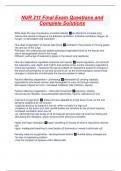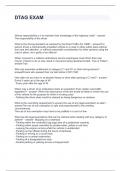NUR 211 Final Exam Questions and
Complete Solutions
What does the use of accessory muscles indicate ✅an attempt to increase lung
volume that results in fatigue is not effective ventilation. Indicates ventilatory fatigue, air
hunger, or decreased lung expansion
How does oxygenation of tissues take place ✅ventilation; the process of moving gases
into and out of the lungs
Perfusion; the cardiovascular system pumping oxygenated blood to the tissues and
return deoxygenated blood to the lungs
Diffusion; exchange of respiratory gases in the alveoli and capillaries
How are respirations regulated (chemical and neural) ✅neural regulation- cns controls
the respiratory rate, depth, and rhythm and cerbral cortex control voluntary respirations
Chemical regulation - maintains the rate and depth of respirations based on changes in
the blood concentrations of co2 and o2 and in ph, so the chemoreceptors sense these
changes in chemicals and stimulate the nervous system to adjust
Factors affecting oxygenation - physiology ✅decreased o2 carrying capacity,
hypovolemia (low blood volume, less hemoglobin to carry o2 through vessels),
decreased inspired o2 conc., increased metabolic rate (infection, sepsis),
Factors affecting oxygenation - chest wall movement ✅prgnancy, obesity,
neuromuscular disease, musculoskeletal deformities, trauma, alterations to cns
Copd and oxygenation ✅-these pts have adapted to a high level of co2, so the co2
sensitive receptors do not function
-copd pts stimulus to breathe is low o2, while normally it is high co2
-receptors in the aortic arch and carotid bodies are sensitive to low o2 level causing
increased ventilation when low o2
-so, administering high levels of o2 to these pts prevents their o2 level from falling and
stimulating the receptors, which removes their stimulus to breathe
Hyper and hypo ventilation ✅hyper- breathing in excess of what is required to remove
co2
Hypo- inadequate breathing to meet bodys o2 demands or needs to eliminate co2
Nursing notes on oxygenation - developmental factors ✅-mental status changes are
1st sign of respiratory problem
-may not complain of dyspea until it affects adls
,- changes in coughing mechanism may lead to retention of secretions and atelectasis
(when using cough suppressants)
-diminshed respiratory muscles from changes in thorax lead to issues w chest
expansion
Nursing note on oxygenation - lifestyle ✅smoking (heart disease, copd, lung cancer),
substance abuse (impairs tissue perfusion), stress (increases metabolic rate and
oxygen demand of the body)
Nursing note on oxygenation - environmental factors ✅the incidence of pulmonary
disease is higher in smoggy, urban areas
-work place risks include asbestosis, coccidiodomycosis
Thorough assessment of oxygenation and systems ✅past impairments of circulatory or
respiratory function, methods pt uses to optimize oxygenation, review of allergies,
physical examination, lab and diagnostic tests.
-hx of chest pain, dyspnea, wheezing, resp. Infections, meds, fatigue, cough, smoking,
exposures
-examine skin and mucous membranes, loc, breathing patterns, chest wall movement,
palpate chest, feet, legs, pulses, auscultate heart and lung sounds
How to assess breath sounds ✅rate, volume (shallow or deep), rhythm (regular or
irregular), effort, ap:lat diameter (1:2), cough (productive or not) - amt., color,
consistency, odor
What causes decreased or absent breath sounds ✅pneumothorax, emphysema,
removed lung lobes, obstruction, atelectasis
Difference between hypoxia and hypoxemia ✅hypoxia - inadequate tissue oxygenation
at cell level
Hypoxemia - low level of oxygen in arterial blood
What is a more invasive way than pulse oximetry of determining level of oxygenation
✅arterial blood gases (abgs) - invasive way to measure partial pressure of o2 in blood.
Normal 80-100
Acute hypoxia ✅sudden - causes? - obstructed airway, pulmonary embolism, impaired
ventilation (asthma, pneumonia)
Sx- anxious, sitting up, increased rr and hr, confusion, behavior changes, nasal flaring -
cyanosis is a late sign
Chronic hypoxia ✅long term - causes? - copd, anemia, impaired ventilation, cardiac
abnormalities
Sx- fatigue, lethargy, clubbed fingers, barrel chest, soa, paroxysmal nocturnal dyspnea,
orthopnea, activity intolerance
, Define orthopnea ✅shortness of breath that occurs when lying flat
An h+h diagnostic blood test ✅hematocrit - % of total blood volume made up by rbcs
Male - 42-52% female - 37-47%
= decreased levels are called anemia
Hemoglobin - iron containing pigment of rbc
Male - 14-18 female 12-16
Ways to promote oxygenation ✅monitor hydration, humidification, administer inhalant
medications (expectorants, mucolytics, bronchodilators, anti inflammatory agents),
teach coughing and breathing, perform chest physiotherapy, suction airway, artificial
airways
What is a method that a nurse can teach the pt to do to increase air to lower lungs
✅diaphragmatic breathing - belly breathing
What is a method you can teach your pts to prevent alveolar collapse ✅pursed lip
breathing - take a deep breath and exhale slowly through pursed lips as if blowing
through a straw - exhalation is longer than inhalation phase
-used to expell as much air as possible and prevent atelectasis in copd pts
Different types of airways ✅oral - displaces tongue to prevent obstruction of trachea
Endotracheal - short term use to ventilate, relieve upper airways obstruction, protect
against aspiration, clear secretions
Tracheosotomy - long term - incision made into trachea
Indications for a tracheostomy ✅acute airway obstruction, airway obstruction, after
head/neck surgery, facilitate removal of secretions
-less damage to the airway, more comfortable, allowed to eat, mobility improved
What is the purpose of a cuff ✅helps prevent aspiration, helps ventilator give stronger
breaths
What are the indications for cpap ✅sleep apnea or heart failure
What are indications for a bi-pap ✅respiratory failure, pulmonary edema, exacerbation
of copd
Describe the nasal cannula and indications for use ✅administers low concentrations
(24-44%), usually administered at 1-6l/min - check for skin breakdown around ears and
cheeks





